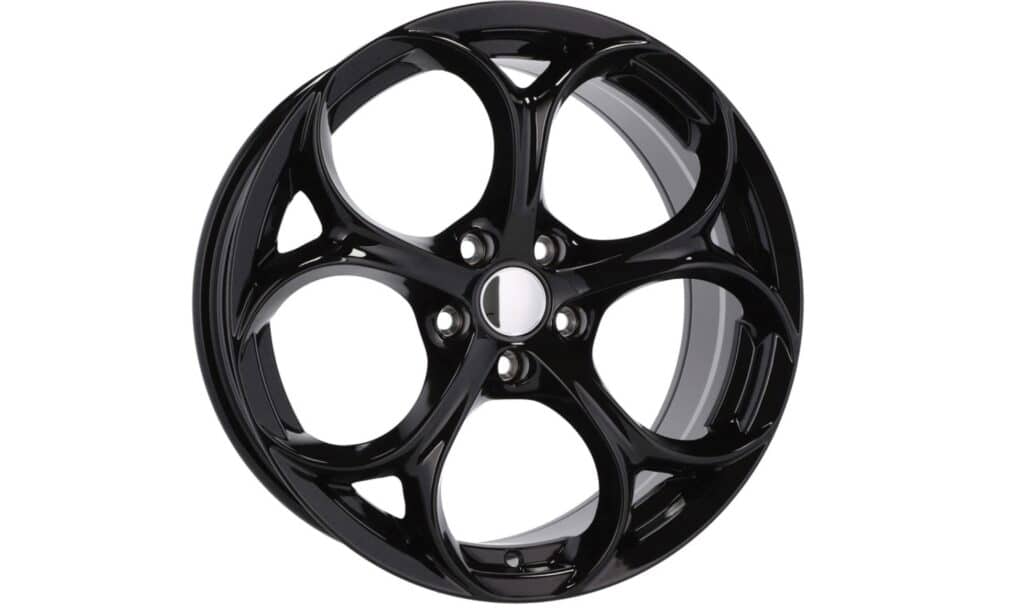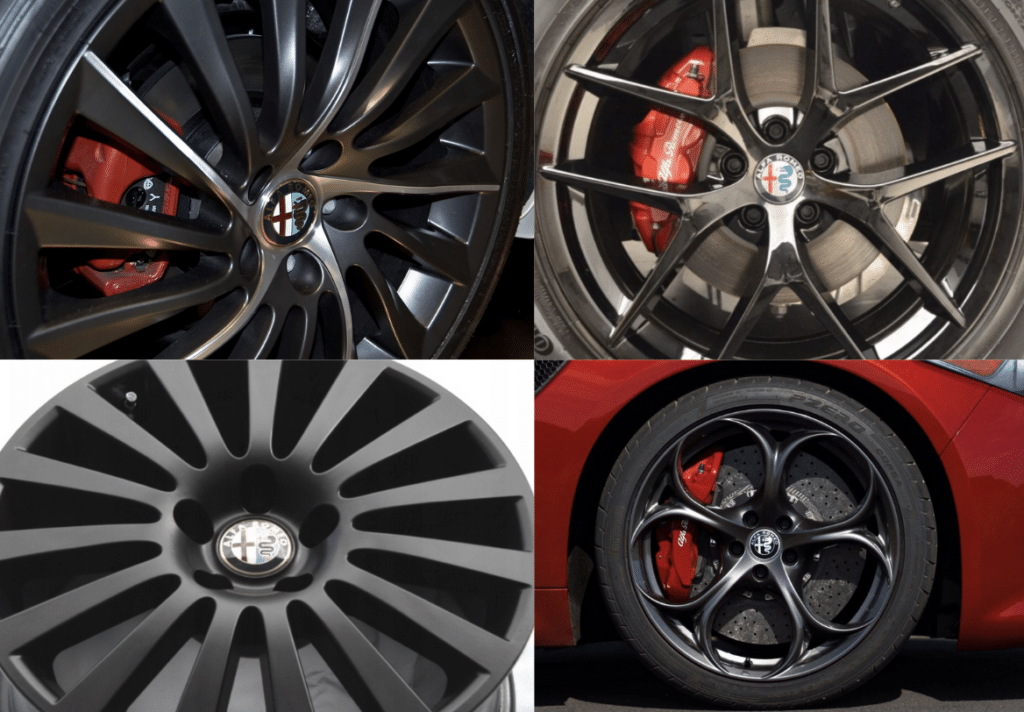After spending fifteen years working on various Italian cars, I’ve learned that Alfa Romeo bolt patterns are like fingerprints – unique to each generation yet telling a story of the brand’s evolution.
Personally, I’ve seen countless enthusiasts struggle with wheel fitments, often realising too late that their dream wheels won’t fit their pride and joy.
That’s why I’m here to share my hands-on experience with these sometimes tricky specifications.
I’ll break down everything about Alfa Romeo bolt patterns – from the classic 4x108mm pattern that adorned the vintage beauties to the modern 5x110mm setup you’ll find on a new Giulia.
If you’re a weekend warrior or a seasoned mechanic, I’ll help you understand exactly what you need to know about your Alfa’s wheel fitment.
What Is the Bolt Pattern for An Alfa Romeo?

Alfa Romeo vehicles typically use different bolt patterns depending on the model and year.
The most common bolt pattern found on modern Alfa Romeo vehicles is 5x110mm, which is used on models like the Giulia and Stelvio.
However, some older models use different patterns – for example, many classic Alfa Romeos from the 1960s and 1970s used a 4x108mm pattern.
- Giulia (2015-present) 5x110mm bolt pattern with 65.1mm center bore. This pattern is shared with several modern Alfa Romeo and Fiat vehicles.
- Stelvio (2017-present) Uses the same 5x110mm pattern as the Giulia, maintaining commonality across their current platform. Hub center bore remains 65.1mm.
- 4C (2013-2020) Features a 5x98mm bolt pattern with 58.1mm center bore, continuing the pattern used in several classic Alfa models.
- 159 (2005-2011) 5x110mm bolt pattern, but with a slightly different 65mm center bore. This was one of the first models to adopt this wider bolt pattern.
- Giulietta (2010-2020) Returns to the traditional 5x98mm pattern with 58.1mm center bore, making it compatible with many earlier Alfa wheels.
When replacing wheels, it’s crucial to verify the exact bolt pattern for your specific Alfa Romeo model and year to ensure proper fitment and safety.
Understanding Alfa Romeo Bolt Patterns and Their Compatibility

New Generation Models (2015-Present)
- The Alfa Romeo Giulia and Stelvio both utilize a 5x110mm bolt pattern, making them compatible with each other’s wheels
- Some wheels from other manufacturers like Fiat and Opel/Vauxhall vehicles that also share this pattern
- The wheel center bore for these models is typically 65.1mm, which is crucial for proper fitment and safety considerations
- These models can accommodate wheel sizes ranging from 17 to 21 inches, depending on the specific trim level and performance package
Mid-Generation Models (2000-2015)
- The Alfa Romeo 159, Brera, and Spider models share a 5x110mm bolt pattern, allowing for wheel interchangeability between these platforms
- The 147, GT, and 156 models use a smaller 5x98mm pattern, making them compatible with each other but not with newer generation vehicles
- The 4C sports car also employs the 5x98mm pattern, despite being a more recent model, due to its specialized chassis design
Classic Models (Pre-2000)
- Many classic Alfa Romeo models from the 1960s and 1970s utilized a 4x108mm pattern, which was common for European vehicles of that era
- The Alfa Romeo 33, 75, and early Spider models used various patterns including 4x98mm and 5x98mm, requiring careful verification before wheel replacement
- Some rare or special edition models may have unique bolt patterns, making aftermarket wheel options more limited
List of The Correct Bolt Pattern for A Different Alfa Romeo Model
| Model | Year Range | Bolt Pattern | Center Bore | Common Wheel Sizes |
|---|---|---|---|---|
| Giulia | 2015-Present | 5x110mm | 65.1mm | 17″-19″ |
| Stelvio | 2017-Present | 5x110mm | 65.1mm | 18″-21″ |
| 4C | 2013-2020 | 5x98mm | 58.1mm | 17″-18″ |
| 159 | 2005-2011 | 5x110mm | 65.1mm | 16″-19″ |
| Brera | 2005-2010 | 5x110mm | 65.1mm | 16″-19″ |
| Spider | 2006-2010 | 5x110mm | 65.1mm | 16″-19″ |
| GT | 2003-2010 | 5x98mm | 58.1mm | 16″-18″ |
| 147 | 2000-2010 | 5x98mm | 58.1mm | 15″-18″ |
| 156 | 1997-2007 | 5x98mm | 58.1mm | 15″-17″ |
| GTV | 1995-2006 | 5x98mm | 58.1mm | 15″-17″ |
| 166 | 1998-2007 | 5x108mm | 58.1mm | 16″-18″ |
| 75 | 1985-1992 | 4x98mm | 58.1mm | 14″-15″ |
| 33 | 1983-1995 | 4x98mm | 58.1mm | 13″-15″ |
| Spider (Classic) | 1966-1994 | 4x108mm | 58.1mm | 14″-15″ |
| Montreal | 1970-1977 | 4x108mm | 58.1mm | 14″-15″ |
How to Identify the Correct Bolt Pattern for A Specific Alfa Romeo Model?
Step 1: Understanding Your Model’s History
- First thing I do is identify the exact year and model – it’s crucial since Alfa Romeo has changed patterns across generations
- The big shift happened around 2015 when they standardized most models to 5x110mm
- Some special editions, especially from the 90s, can have unique patterns
- I’ve learned that even within the same model year, different trim levels might have different bolt patterns
- Take the 156 for example – base models used 5x98mm, but some GTA versions had different specs
Step 2: Direct Measurement Technique
- My favorite method is measuring from center to center of opposite bolt holes
- For 5-lug patterns, I measure diagonally across the hub face
- Always use millimeters – I learned this the hard way after a costly mistake with inch measurements
- Remember to measure the center bore too – it’s just as important as the bolt pattern
- Take multiple measurements to ensure accuracy – bolt holes can sometimes be slightly ovalized from wear
- Document your measurements with photos – trust me, you’ll thank me later
Step 3: Using Your VIN
- Locate your VIN on the driver’s side dashboard or door jamb
- Contact an Alfa dealer with this number – they can pull exact specifications
- Keep in mind that modifications by previous owners might mean current wheels don’t match original specs
- Online VIN decoders can help, but I always double-check their info
Step 4: Physical Inspection
- Look for stamped numbers on your current wheels – usually on the back face
- Check for any spacers that might have been installed
- Take note of any modifications to the hub or mounting surface
- Write down the tire sizes while you’re at it – they’re part of the fitment puzzle
Step 4: Professional Resources
- Build a relationship with a trusted Alfa specialist
- Ask them to document their measurements and recommendations
- Join owner forums – I’ve found some incredible databases there
- Consider getting a professional wheel fitment guide for your specific model
- Most importantly, keep all documentation for future reference
Comparisons Between Alfa Romeo’s and Other Brands’ Bolt Patterns with Prices
| Brand & Model | Bolt Pattern | Compatible With | Average Wheel Price Range (USD) |
|---|---|---|---|
| Alfa Romeo Giulia/Stelvio | 5x110mm | Fiat 500X, Jeep Renegade, Opel Astra | $200-450 per wheel |
| BMW 3/5 Series | 5x120mm | BMW X3, X5, Some Volvos | $250-600 per wheel |
| Mercedes C/E Class | 5x112mm | Audi A4/A6, VW Models | $275-650 per wheel |
| Audi A4/A5 | 5x112mm | Mercedes, VW, Skoda | $240-550 per wheel |
| Lexus IS/ES | 5×114.3mm | Toyota, Honda, Nissan | $180-400 per wheel |
| Volvo S60/V60 | 5x108mm | Ford, Peugeot, Jaguar | $220-500 per wheel |
| Maserati Ghibli | 5×114.3mm | Lexus, Infiniti | $400-900 per wheel |
Ways to Maintain Bolt Patterns on Your Alfa Romeo
Regular Inspection & Cleaning:
- Schedule monthly checks of your lug nuts and bolt patterns
- cleaning any debris or rust buildup from the mounting surfaces.
- Use a wire brush to gently clean around each lug nut area.
- Pay special attention to salt buildup in winter months.
- Consider applying a thin coat of rust inhibitor if you live in a coastal or high-moisture area.
Proper Torque Maintenance:
- Always use a calibrated torque wrench to tighten lug nuts to the manufacturer’s specifications – for most Alfa Romeos, this is between 85-95 ft-lbs.
- Recheck torque settings after the first 50 miles of driving following any wheel removal or rotation.
- Invest in a quality beam-style torque wrench rather than a click-type for more accurate measurements.
Cross-Pattern Tightening:
- When installing wheels, follow the star or cross pattern sequence to ensure even pressure distribution and prevent warping of the hub or rotor.
- Start with hand-tightening all lug nuts before using any tools to ensure proper threading.
- Make three passes around the wheel, gradually increasing torque until reaching final specifications.
Thread Protection:
- Apply a thin layer of anti-seize compound on the threads during wheel changes
- Be careful and avoid getting any on the mating surfaces of the wheel or hub.
- Clean threads thoroughly with a wire brush before applying new anti-seize compound.
- Mark your lug nuts with paint markers to quickly identify any that may be loosening between checks.
Professional Hub Alignment:
- Have your wheel hubs professionally checked for alignment every 20,000 miles or if you notice any vibration.
- Listen for any unusual noises when turning at low speeds, as this could indicate hub alignment issues.
- Keep detailed records of hub measurements to track any gradual changes over time.
Conclusion
Just as every Alfa Romeo tells a unique story, its bolt patterns are a crucial chapter in the tale of perfect fitment.
Through our understanding of these patterns – from the classic 4x108mm of the vintage models to the modern 5x110mm of the Giulia – we’ve uncovered the precision that makes these Italian machines truly special.
If you found this guide helpful, you might enjoy my previous deep insights into “A Guide to Fiat Bolt Patterns” – after all, these Italian cousins share more than just heritage.
Remember, if you’re restoring a classic Spider or maintaining a new Stelvio, the right bolt pattern isn’t just about measurements – it’s about preserving the engineering excellence that makes Alfa Romeo unique.
Keep these specifications handy, and you’ll never go wrong with your wheel fitment.


